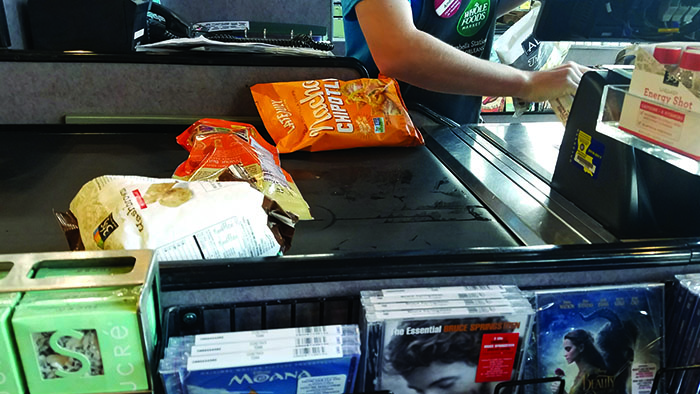Millennials disrupt usage of traditional grocery stores
A Whole Foods employee scans food items. The number of people shopping for groceries through digital platforms is increasing rapidly especially within the millennial generation, according to a Gallup report.
April 30, 2017
Some milennials aren’t running to the grocery story often because online shopping is becoming more prevalent.
According to a Gallup report, millennials are leading the move away from traditional grocery stores with their shopping habits. About 52 percent of millennials said they spend more on groceries, which is down from last year and compares to the 58 percent of people from other generations that said they spend more on groceries.
Felipe Massa, College of Business assistant professor, said that although the technology allowing for this trend has been around since the 2000s, early companies like Webvan, have failed at steering business away from traditional grocery stores.
“I think that the story of the technology disruption in the grocery business is an older one than most people think. A lot of the technology that was in place back then is the same technology that is in place now. I think what has changed isn’t necessarily the technology, but the comfort people have ordering food online and ordering things in general online,” Massa said.
Gallup recommends that grocery retailers change their tactics to appeal to millennials. Jasmine Coleman, A’16, is one millennial who said traditional brick and mortar grocery stores don’t appeal to her.
“I don’t like the feel or the layout. I don’t like the temperature. I like to shop by myself, so I can be in and out. At this point in time, I don’t have to feed a family or cook for myself all the time. I don’t have to go to a traditional grocery store, so maybe they are catering to others that do. I have more options right now, but maybe in the future traditional grocery stores will be different,” Coleman said.
Nathan Fryzek, economics junior also sees issues with traditional grocery stores. Although he hasn’t bought online, he said he would consider it.
“If it’s the same price or only slightly more, I definitely would while in school. I enjoy grocery shopping as a leisure activity though, so when I have time I’d prefer to shop in person,” Fryzek said.
A report by retail advisory companies Unata and Brick Meets Click found that the number of U.S. shoppers who bought groceries online in 2016 more than doubled to 19 percent compared to 8 percent in 2015.
In addition, the number of U.S. shoppers who buy groceries online will grow by more than 60 percent this coming year, with 31 percent of people they surveyed saying they are “very likely” or “somewhat likely” to buy groceries online in 2017, according to the study.
For shoppers who tried E-Grocery, or the use of online devices to order groceries in 2016, 80 percent did so more than once according to the study by Unata and Brick Meets Click.
“Brick and mortars have to respond by moving online if they want to retain that business,” said Gary Hawkins, Center for Advancing Retail founder and CEO.
Many retailers are experimenting with ways to entice customers to continue shopping with them by adding more of a digital presence with digital coupons and subscriptions services.
“I don’t typically like grocery stores, but Kroger’s has a service. It lets you pick out exactly what you want. It’s great for people who are picky like me. I don’t have a monthly subscription, but I might invest in one in the future,” Coleman said.
Between 2008 and 2015, daily spending among 19- to 35-year olds has decreased by $13 per day with the number of millennial consumers in the U.S. This amounts to a spending shortage of approximately $949 million per day, according to a Gallup report.
With these numbers, many retailers are looking for ways to appeal
to millennials.
“Brick and mortar retail is at risk here, and a good part of the industry is moving online. There was a recent study by Nielsen that said 25 percent of industry sales will be done online by 2025. That’s within eight years. There is no brick and mortar that can afford to lose 25 percent of their top line sales and remain profitable,” Hawkins said.
With companies like Amazon delivering groceries to people’s homes, traditional grocery stores must decide how they can compete. “Certainly Amazon, who’s the big monster in the room, poses a threat to any brick and mortar company, whether it is Kroger, the largest traditional supermarket company in the country to Walmart, down to smaller, independent operators,” Hawkins said. “Amazon is very, very aggressive in moving into online shopping. They are also experimenting with brick and mortar stores with Amazon Go, which is a pilot store in Seattle which is fully automated. There are no people in it except the customers.”









Matt Wilson • May 1, 2017 at 8:43 am
Under30Experiences brings young people on trips to Costa Rica where we eat all organic food grown at the eco-lodge 3x daily. People come back from that trip signing up for things like Thrive Market, signing up for co-ops and visiting local farms in their area after they realize how good they feel!